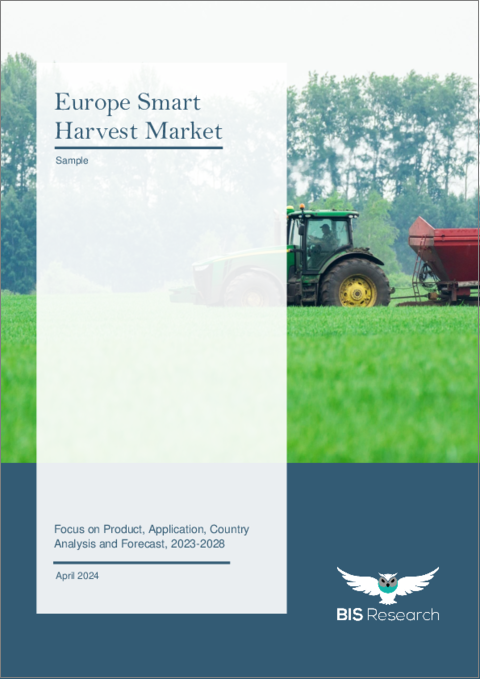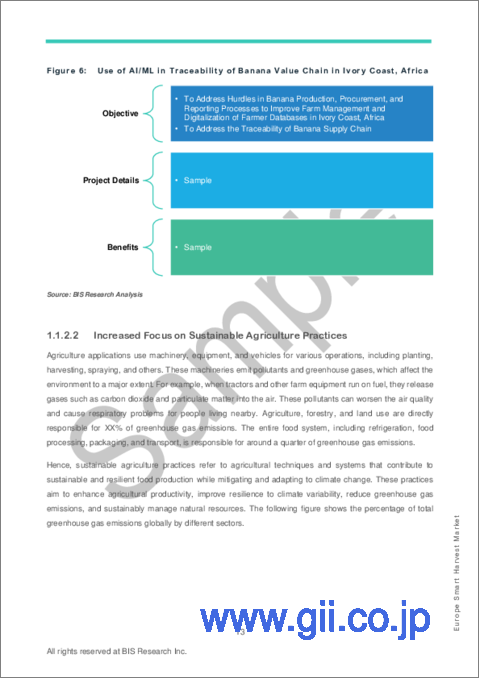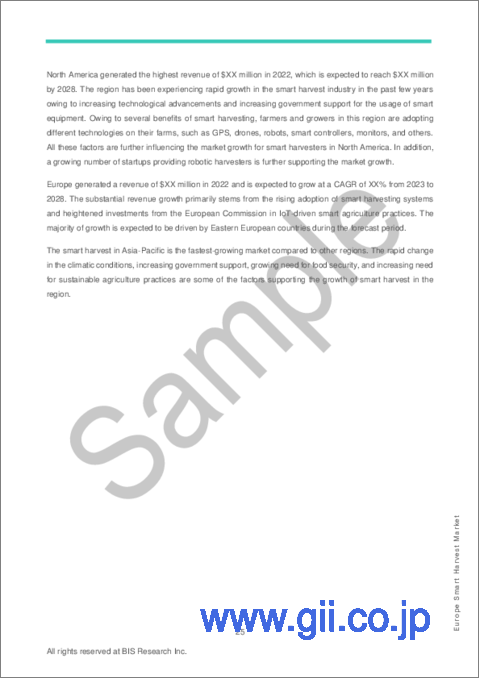|
|
市場調査レポート
商品コード
1466829
欧州のスマートハーベスト市場:製品別、用途別、国別:分析と予測(2023年~2028年)Europe Smart Harvest Market: Focus on Product, Application, Country - Analysis and Forecast, 2023-2028 |
||||||
|
● お客様のご希望に応じて、既存データの加工や未掲載情報(例:国別セグメント)の追加などの対応が可能です。 詳細はお問い合わせください。 |
|||||||
| 欧州のスマートハーベスト市場:製品別、用途別、国別:分析と予測(2023年~2028年) |
|
出版日: 2024年04月23日
発行: BIS Research
ページ情報: 英文 93 Pages
納期: 1~5営業日
|
- 全表示
- 概要
- 図表
- 目次
欧州のスマートハーベストの市場規模(英国を除く)は、2023年に11億2,170万米ドルとなりました。
同市場は、予測期間の2023年~2028年に10.7%のCAGRで拡大し、2028年には18億6,440万米ドルに達すると予測されています。この拡大は、農業業界が投入コストを下げながら作物の収量を増やすことを重視するようになったことが主な要因です。スマート収穫システムは、生産管理、収穫アプリケーションの改善、効率的な収穫への正確で集中的なアプローチを提供します。これらの技術は、農家がデータに基づいた意思決定を行い、作業効率を改善し、資源の浪費を減らし、環境への影響を抑えることを可能にすることで、今後数年間、世界のスマートハーベスト市場の成長を促進すると予測されています。
| 主要市場統計 | |
|---|---|
| 予測期間 | 2023年~2028年 |
| 2023年評価 | 11億2,170万米ドル |
| 2028年予測 | 18億6,440万米ドル |
| CAGR | 10.7% |
スマートハーベストは、農業ビジネスを変革する可能性を秘めた最先端の農業技術ソリューションです。この新戦略は、食糧生産への需要が増大する世界において、農業分野のあらゆる企業に大きな利益をもたらします。スマートハーベストシステムは、高度なセンサー、データ分析、自動化を用いて、作物管理と収穫の成果を向上させます。これにより、農家は情報に基づいた意思決定を行い、作物の健康状態を正確にモニターし、水や肥料などの資源をより効率的に管理できるようになります。その結果、生産性と収益性が向上し、廃棄物や環境への影響が減少します。
スマートハーベストは、リアルタイムのデータインサイトの提供により、変化する気象条件、市場の需要、資源の利用可能性に対応することを可能にします。この技術により、持続可能で強固な作物生産が可能になり、小規模経営者であれ大手農業組織であれ、最終的には顧客の収益を確保することができます。顧客の農業会社にスマートハーベストを組み込むことは、経営効率を向上させるだけでなく、革新的で環境に配慮した業界のリーダーとしての地位を確立します。
市場の拡大には様々な重要な要素が影響しています。世界の食糧需要の拡大、水資源や耕地の減少、農業労働力の不足、収穫労働費などの農業投入コストの上昇傾向などです。これらの理由により、農業セクター全体におけるスマートハーベストテクノロジーの利用増加が促されると予想されます。これらの最先端技術により、農家は資源配分を改善し、作物生産量を増やし、最終的に農業生産性を向上させることができます。
当レポートでは、欧州のスマートハーベスト市場について調査し、市場の概要とともに、製品別、用途別、国別の動向、および市場に参入する企業のプロファイルなどを提供しています。
目次
調査範囲
エグゼクティブサマリー
第1章 市場
- 業界展望
- ビジネスダイナミクス
- ケーススタディ
- スタートアップの情勢
- 市場における主要製品のアーキテクチャ/技術比較
第2章 地域
- 欧州
- ドイツ
- フランス
- オランダ
- イタリア
- ウクライナ
- ベルギー
- スイス
- ギリシャ
- スペイン
- その他
- 英国
第3章 市場:競合ベンチマーキングと企業プロファイル
- 競合ベンチマーキング
- ロボット収穫機企業
- 自走式スマートハーベスター企業
- ロボット収穫機メーカーの市場シェア分析
- 自走式スマートハーベスターメーカーの市場シェア分析
- 企業プロファイル
- Agrobot
- Antobot Ltd.
- AMB Rousset
- CNH Industrial N.V.
第4章 調査手法
List of Figures
- Figure 1: Scope Definition
- Figure 2: Smart Harvest Market Coverage
- Figure 3: Factors Driving the Need for Smart Harvesting
- Figure 4: Europe Smart Harvest Market, $Billion, 2022-2028
- Figure 5: Europe Smart Harvest Market (by Site of Operation), $Billion, 2022 and 2028
- Figure 6: Europe Smart Harvest Market (by Product), $Billion, 2022 and 2028
- Figure 7: Smart Harvest Market (by Region), 2022
- Figure 8: Use of AI/ML in Traceability of Banana Value Chain in Ivory Coast, Africa
- Figure 9: Greenhouse Gas Emissions (Carbon Dioxide (CO2) Eq.) by Sector, Share (%), 2022
- Figure 10: Estimated Food Loss at Different Stages in Entire Supply Chain
- Figure 11: Average Labor Cost of Various Agricultural Operations, %, 2019-2022
- Figure 12: Product Development and Innovation (by Company), January 2018-June 2023
- Figure 13: Partnerships, Joint Ventures, Collaborations, and Alliances (by Company), January 2018-June 2023
- Figure 14: Agriculture Technology-as-a-Service (ATaaS) Market Revenue, $Million, 2022-2028
- Figure 15: Smart Harvesting Case Study - Extentia Information Technology
- Figure 16: Automation of Crop Yield Assessment Case Study
- Figure 17: Lettuce Harvesting Robot Case Study
- Figure 18: Total Investment and Number of Funding Deals, $Million, January 2020-December 2022
- Figure 19: Top Funding Deals in Smart Harvest Market, $Million, 2022
- Figure 20: Funding (by Technology), 2022
- Figure 21: Funding (by Year), $Million, 2021 and 2022
- Figure 22: Competitive Benchmarking for Robotic Harvester Companies
- Figure 23: Competitive Benchmarking for Self-Propelled Smart Harvester Companies
- Figure 24: Market Share Analysis of Robotic Harvester Manufacturers, 2022
- Figure 25: Market Share Analysis of Self-Propelled Smart Harvester Manufacturers, 2022
- Figure 26: Agrobot: Product Portfolio
- Figure 27: Antobot Ltd.: Product Portfolio
- Figure 28: AMB Rousset: Product Portfolio
- Figure 29: CNH Industrial N.V.: Product Portfolio
- Figure 30: Data Triangulation
- Figure 31: Top-Down and Bottom-Up Approach
- Figure 32: Assumptions and Limitations
List of Tables
- Table 1: Key Consortiums and Associations in the Smart Harvest Market
- Table 2: Key Regulatory Bodies
- Table 3: Key Government Initiatives/Programs
- Table 4: Key Startups in the Smart Harvest Market
- Table 5: Technical Parameters Comparison for Robotic Harvesters: MetoMotion vs. Harvest Automation
- Table 6: Smart Harvest Market (by Region), $Million, 2022-2028
Introduction to Europe Smart Harvest Market
The Europe smart harvest market (excluding U.K.) was valued at $1,121.7 million in 2023 and is anticipated to reach $1,864.4 million by 2028, witnessing a CAGR of 10.7% during the forecast period 2023-2028. This expansion is mostly driven by the agriculture industry's growing emphasis on increasing crop yields while lowering input costs. Smart harvesting systems provide accurate and focused approaches to production management, improved harvesting application, and efficient harvesting. These technologies are anticipated to fuel the growth of the worldwide smart harvest market in the next years by enabling farmers to make data-driven decisions, improve operational efficiency, decrease resource waste, and limit environmental impact.
| KEY MARKET STATISTICS | |
|---|---|
| Forecast Period | 2023 - 2028 |
| 2023 Evaluation | $1,121.7 Million |
| 2028 Forecast | $1,864.4 Million |
| CAGR | 10.7% |
Market Introduction
Smart harvest is a cutting-edge agricultural technology solution that has the potential to transform the farming business. This new strategy offers significant benefits to enterprises throughout the agricultural spectrum in a world where food production demands are increasing. A smart harvest system uses advanced sensors, data analytics, and automation to improve crop management and yield outcomes. It enables farmers to make informed decisions, precisely monitor crop health, and manage resources like water and fertilizer more efficiently. As a result, productivity and profitability grow while waste and environmental impact decrease.
Smart harvest enables organizations to react to changing weather conditions, market demands, and resource availability by providing real-time data insights. This technology enables sustainable and robust crop production, eventually securing the customer's bottom line, whether the customer is a small-scale operator or a major agricultural organization. Incorporating smart harvest into the customer's agricultural company not only improves operational efficiency, but it also positions the customer as an innovative and environmentally conscious industry leader.
A variety of key elements influence the market's expansion. These include the growing global food demand, the decreasing availability of water resources and arable land, the shortage of agricultural labor, and the rising trend in agricultural input costs such as harvesting labor expenses. These reasons are expected to stimulate increased use of smart harvest technology in the agriculture sector as a whole. These cutting-edge technologies enable farmers to improve resource allocation, increase crop production, and ultimately increase agricultural productivity.
Market Segmentation:
Segmentation 1: by Site of Operation
- On-Field
- Controlled Environment
Segmentation 2: by Product
- Robotic Harvester
- Self-Propelled Smart Harvester
- Others
Segmentation 3: by Country
- Germany
- France
- Italy
- Spain
- The Netherlands
- Belgium
- Switzerland
- Ukraine
- Greece
- Rest-of Europe
How can this report add value to an organization?
Product/Innovation Strategy: The product segment helps the reader to understand the different technologies used for smart harvest and their potential globally. Moreover, the study gives the reader a detailed understanding of the different solutions provided by smart harvest providers for imaging, processing, and analyzing. Compared to conventional agricultural methods, smart harvest enables more exact targeting of harvest, crop mapping, and crop growth detection, allowing farmers to save money by maximizing the use of their inputs.
Growth/Marketing Strategy: The Europe smart harvest market has seen major development by key players operating in the market, such as business expansion, partnership, collaboration, and joint venture. The favored strategy for the companies has been partnership, collaboration, and joint venture activities to strengthen their position in the global smart harvest market.
Competitive Strategy: Key players in the Europe smart harvest market analyzed and profiled in the study involve smart harvest-based product manufacturers, including market segments covered by distinct product kinds, applications served, and regional presence, as well as the influence of important market tactics employed. Moreover, a detailed competitive benchmarking of the players operating in the global smart harvest market has been done to help the reader understand how players stack against each other, presenting a clear market landscape. Additionally, comprehensive competitive strategies such as partnerships, agreements, and collaborations will aid the reader in understanding the untapped revenue pockets in the market.
Key Market Players and Competition Synopsis
The companies that are profiled have been selected based on inputs gathered from primary experts and analyzing company coverage, type portfolio, and market penetration.
Some prominent names in the market include:
- Agrobot
- AMB Rousset
Table of Contents
Scope of the Study
Executive Summary
1 Market
- 1.1 Industry Outlook
- 1.1.1 Market Definition
- 1.1.2 Market Trends
- 1.1.2.1 Role of Artificial Intelligence and Machine Learning in Smart Harvesting
- 1.1.2.2 Increased Focus on Sustainable Agriculture Practices
- 1.1.3 Ecosystem/Ongoing Programs
- 1.1.3.1 Consortiums and Associations
- 1.1.3.2 Regulatory Bodies
- 1.1.3.3 Government Initiatives/Programs
- 1.2 Business Dynamics
- 1.2.1 Business Drivers
- 1.2.1.1 Rising Crop Losses Caused by Improper Harvesting Practices
- 1.2.1.1.1 Minimizing Crop Yield Depletion throughout Harvesting Process
- 1.2.1.2 Need for Reducing the Cost of Crop Production
- 1.2.1.2.1 Optimizing Farm Profitability through Climate-Resilient Smart Harvest Solutions
- 1.2.1.1 Rising Crop Losses Caused by Improper Harvesting Practices
- 1.2.2 Business Challenges
- 1.2.2.1 Less Adoption of Smart Harvesters among Small-Scale Farmers
- 1.2.2.2 High Initial Cost of Smart Harvesting Equipment
- 1.2.2.3 Technical Complexities Affecting Smart Harvest Adoption
- 1.2.3 Business Strategies
- 1.2.3.1 Product Development and Innovation
- 1.2.3.2 Market Development
- 1.2.4 Corporate Strategies
- 1.2.4.1 Partnerships, Joint Ventures, Collaborations, and Alliances
- 1.2.5 Business Opportunities
- 1.2.5.1 Integration of Smart Technologies in Agriculture Machineries or Equipment
- 1.2.5.2 Development of Innovative and Affordable Small Harvesting Robot
- 1.2.5.3 Government Initiatives to Promote Digital Agriculture
- 1.2.5.4 Opportunities in ATaaS Market
- 1.2.1 Business Drivers
- 1.3 Case Studies
- 1.3.1 Smart Harvesting Case Study
- 1.3.2 Automation of Crop Yield Assessment Case Study
- 1.3.3 Lettuce Harvesting Robot Case Study
- 1.4 Startup Landscape
- 1.4.1 Startup Traction Analysis (by Product)
- 1.4.2 Funding Analysis
- 1.4.2.1 Total Investments and Number of Funding Deals
- 1.4.2.2 Top Funding Deals, 2022
- 1.4.2.3 Funding (by Technology)
- 1.4.2.4 Funding (by Year)
- 1.5 Architectural/Technical Comparison of Key Products in the Market
2 Region
- 2.1 Europe
- 2.1.1 Germany
- 2.1.2 France
- 2.1.3 Netherlands
- 2.1.4 Italy
- 2.1.5 Ukraine
- 2.1.6 Belgium
- 2.1.7 Switzerland
- 2.1.8 Greece
- 2.1.9 Spain
- 2.1.10 Rest-of-Europe
- 2.2 U.K.
3 Markets - Competitive Benchmarking & Company Profiles
- 3.1 Competitive Benchmarking
- 3.1.1 Robotic Harvester Companies
- 3.1.2 Self-Propelled Smart Harvester Companies
- 3.1.3 Market Share Analysis of Robotic Harvester Manufacturers
- 3.1.4 Market Share Analysis of Self-Propelled Smart Harvester Manufacturers
- 3.2 Company Profiles
- 3.2.1 Agrobot
- 3.2.1.1 Company Overview
- 3.2.1.2 Product Portfolio
- 3.2.1.3 Customer Profiles
- 3.2.1.3.1 Target Customers
- 3.2.1.4 Analyst View
- 3.2.2 Antobot Ltd.
- 3.2.2.1 Company Overview
- 3.2.2.2 Product Portfolio
- 3.2.2.3 Customer Profiles
- 3.2.2.3.1 Target Customers
- 3.2.2.4 Analyst View
- 3.2.3 AMB Rousset
- 3.2.3.1 Company Overview
- 3.2.3.2 Product Portfolio
- 3.2.3.3 Customer Profiles
- 3.2.3.3.1 Target Customers
- 3.2.3.4 Analyst View
- 3.2.4 CNH Industrial N.V.
- 3.2.4.1 Company Overview
- 3.2.4.2 Product Portfolio
- 3.2.4.3 Customer Profile
- 3.2.4.3.1 Target Customers
- 3.2.4.4 Analyst View
- 3.2.1 Agrobot
4 Research Methodology
- 4.1 Data Sources
- 4.1.1 Primary Data Sources
- 4.1.2 Secondary Data Sources
- 4.1.3 Data Triangulation
- 4.2 Market Estimation and Forecast




